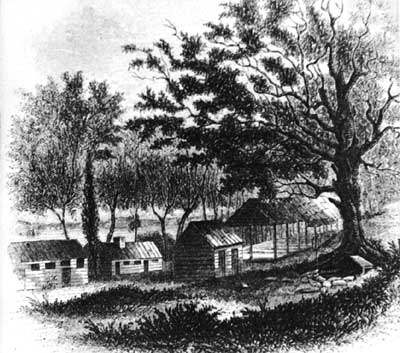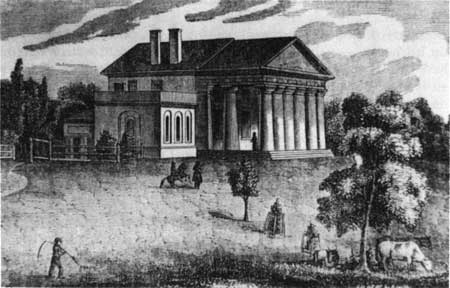|
CUSTIS-LEE MANSION The Robert E. Lee Memorial |
 |

"Arlington House," as it appeared from about 1804-1816.
History of Arlington to 1861 (continued)
ARLINGTON AND THE DEVELOPMENT OF AMERICAN AGRICULTURE. While building his house, Custis inaugurated an annual fair designed to improve agricultural practices in general, and particularly the breeding of fine-wooled sheep. Beginning in 1803, Custis invited the local gentry each spring to exhibit their best sheep and homespun cloth at Arlington Spring, near the edge of the river. After prizes had been awarded, the fair would close with patriotic speeches and a great dinner under the tent which had been used by Washington during the Revolution.
By breeding the native stock on his farms with the imported stock he had acquired from Mount Vernon, Custis himself developed a hardy race of fine-wooled sheep, known as the "Arlington Improved." Because the wool of this breed could be woven into finer cloth than hitherto possible, the Arlington sheep were widely diffused throughout the country. Custis also sought to correct the primitive agricultural methods which had already caused much land in his State to be abandoned because of soil erosion. He advocated the establishment of a National Board of Agriculture with functions like those of the Department of Agriculture today, and he offered one of his outlying properties for use as an experimental breeding station. So popular was the Arlington Sheepshearing, as it was commonly called, that the idea was quickly adopted elsewhere. Though economic conditions forced Custis to discontinue the event after 1812, it was one of the primary sources of the great program of agricultural improvement in effect today.

Arlington Spring, scene of the famous "Sheepshearings."
BIRTH OF MARY ANNA RANDOLPH CUSTIS. Mary Anna Randolph Custis, born in 1808, was the only one of the four Custis children to survive the first year of infancy. Upon her the parents centered their affections and hopes. The mother's natural piety and devotion to her family were deepened by the loss of her other children, while the father's warm and generous nature was such that in later years she could not recall ever having received an unkind word from him.
CUSTIS AND THE WAR OF 1812. During the War of 1812, the British blockade of the Chesapeake deprived Custis of much of the income from his other estates, so it is doubtful if any building was done at Arlington at this time. Convinced that Napoleon threatened the liberties of mankind more than England, Custis strongly opposed the war. For this reason he was chosen to deliver the funeral oration for General Lingan, a veteran of the Revolution who was murdered by the same Baltimore mob which almost killed Robert E. Lee's father, "Light-Horse Harry" Lee. Nevertheless, Custis followed the example set by George Washington during the American Revolution by forbidding the managers of his plantations to furnish supplies to the British; and when British troops approached the National Capital in 1814, Custis fought in the ranks at the battle of Bladensburg.
"ARLINGTON HOUSE" COMPLETED. After the war, Custis resumed work on his house, and the large center section and great portico were to have been finished in 1817. "A house that any one might see with half an eye," as Robert E. Lee later described it, could not fail to attract attention, and "Custis' Folly" is first mentioned by a traveler in 1818. Although the interior was never completed as planned and the rear was left unstuccoed, "Arlington House" was soon considered one of the handsomest residences about Washington. One early writer describes it as "a noble-looking place, having a portico of stately white columns, which, as the mansion stands high, with a background of dark woods, forms a beautiful object in the landscape."
THE MEMORY OF GEORGE WASHINGTON KEPT ALIVE AT ARLINGTON. "Arlington House" now became the successor of Mount Vernon as the "Washington Treasury," as Custis termed it. His collection of Washington relics was the largest in existence, and it filled the halls and rooms of the mansion. The owner of these relics welcomed all who wished to view them, and he never tired of entertaining his guests with tales of his early years at Mount Vernon. Many distinguished men visited Arlington at one time or other—Sam Houston, Daniel Webster, and Andrew Jackson, to name a few. One of the most notable was General Lafayette, who twice was a guest there when he toured the United States in 1824 and 1825. Custis spent much time with the venerable marquis, and used the wealth of reminiscenses he gained from the old soldier to write the delightful Conversations With Lafayette, which was published in a local newspaper in 1825. Encouraged by their favorable reception, he then began his own Recollections and Private Memoirs of Washington, which proved equally popular and were widely reprinted in the newspapers of the period.

An early view of "Arlington House."
From an engraving made about 1845.
Even more successful were the dramas Custis wrote at this time, based on heroic episodes in the Nation's past or on inspiring contemporary achievements. The Indian Prophecy used an incident in Washington's early life as its theme and established a vogue for Indian plays which lasted over 50 years; while the Rail Road was the first one written on that subject in America. Others dramatized such events as the battle of Baltimore and the launching of a new warship. For 10 years his dramatic pieces were staged from Boston to Charleston and did much to develop a distinctive American drama.
A man of culture, Custis used all of his abilities to perpetuate the memory of Washington. He erected the first monument on the President's birthplace in 1816, wrote poems to celebrate his greatness, and painted colorful battle pictures in which the great General was the central figure. An accomplished orator, he was tireless in advocating the principles of freedom for which Washington had fought, and planned to do with his slaves as his foster father had done—free them after they had been prepared to shift for themselves. Although he never held an elective office, his influence was considerable and for the good.

|

| History | Links to the Past | National Park Service | Search | Contact |
|
Last Modified: Mon, Dec 2 2002 10:00:00 am PDT |

